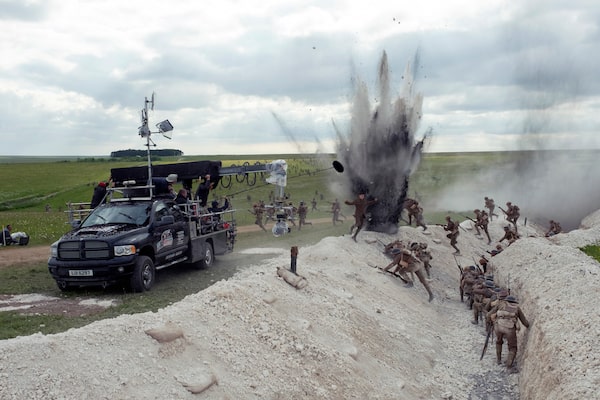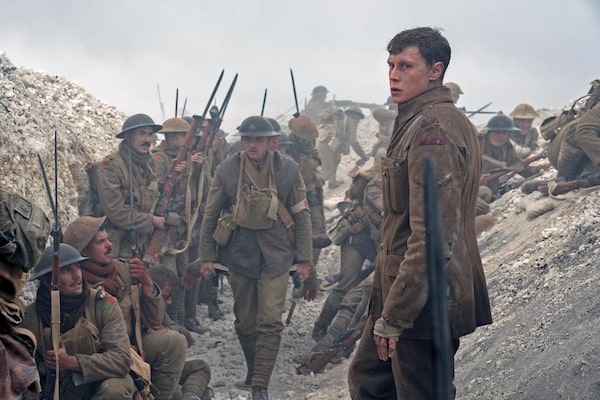
Just four years ago, Krysty Wilson-Cairns, seen here on Dec. 4, 2019, was tending bar in London.TOLGA AKMEN/AFP/Getty Images
Time is the enemy. That’s the tag line for the new First World War drama 1917, a tick-tock thriller that follows two young British soldiers as they race across enemy lines in northern France to deliver a battalion-saving message. Shot in real-time – as if the action was captured in one long uninterrupted shot (more or less) – director Sam Mendes’s film indeed finds a worthy adversary in the unstoppable march of minutes and seconds. But time can also be a friend – at least to Krysty Wilson-Cairns, the co-writer of 1917 and one of the fastest-rising screenwriters in the industry today.
Just four years ago, Wilson-Cairns was tending bar in London, having recently graduated from the National Film and Television School with a master of fine arts degree in screenwriting. When the pub wasn’t busy, she pulled out her laptop and hammered away at her first spec script, a high-concept sci-fi film called Aether (elevator pitch: Minority Report meets Prime Suspect). In her off-hours, the Glasgow native kept writing in her apartment, which was located above a strip club. Like so many would-be screenwriters, Wilson-Cairns didn’t have an industry connection. She didn’t start in the mailroom of an agency. She only had a day job, passion, and a lot of “really weird stories.”
Holiday movie guide: Reviews of films opening through the end of December
But the very-weird-indeed Aether struck a chord with her U.K. agent, and in 2014, the script found its way onto the Black List, a coveted annual collection of the best un-produced screenplays as selected by Hollywood executives and agents. And then, as they say, one thing led to another. And another. Soon – very soon – Wilson-Cairns was writing on the third season of the Showtime series Penny Dreadful. And soon after that – extraordinarily soon – Penny Dreadful’s executive producer Mendes (Skyfall, American Beauty) hired her to write his adaptation of Gay Talese’s controversial 2016 feature for The New Yorker, “The Voyeur’s Motel." That project fell apart due to rights issues. As did the next film that Mendes asked her to handle. But soon – really, extremely, frightfully soon – Mendes phoned again.

Director Sam Mendes says that without Wilson-Cairns, 1917 'would still be an unfinished file on my desktop.'Photo Credit: François Duhamel/Universal Pictures
“Sam said that he wanted to do a war film, but a very different type of war film. He had this one image in his head, of his grandfather carrying a letter through no man’s land, and he thought there was an idea there,” Wilson-Cairns, 31, says during a press stop in Toronto the other week. “And then, just before he hung up, he added, ‘Oh yeah, it’s all going to be one shot.’ So it went from being my dream job to my really, really, really difficult dream job.”
But, she adds, it was still a dream. And even more unlikely in the here-today-gone-tomorrow world of Hollywood, it has remained a dream throughout an enormously challenging production process. One during which, again, time was less an enemy and more an unlikely friend. Despite being handed a near-unprecedented assignment – “There have been one-shot films made before, but the problem is that this story doesn’t repeat locations, it’s constantly moving, and you’re never cutting,” says Wilson-Cairns, “so I had to invent a slightly new form of script for this, and while you can stretch reality like rubber, you can only go so far before the audience doesn’t believe you … It was a fun and inventive experience in punishment” – she turned around a script in just six weeks.
“She surprised me on many levels. Partly because she knew so much about the war already and had fully formed opinions on it, partly because she is from a different generation as me and had such a different perspective on everything and made it happen so quickly,” says Mendes, 54. “Without her, it would still be an unfinished file on my desktop.”
Normally, this is where the writer’s job ends. They go back to their desk – or bar rail – and wait and hope that the finished product vaguely resembles the words they originally wrote. Except, because nothing about Wilson-Cairns’s story is quite normal, her back-and-forth with Mendes on 1917′s script was just the beginning. Soon, Wilson-Cairns was a constant presence during the film’s intense four-month rehearsal period and its subsequent shoot.

The film was shot in natural light.Photo Credit: François Duhamel/Universal Pictures
“It was a bit unusual, a bit weird. But I think there should be a push to have more writers on-set – we’re useful!” she says with a laugh. “We’re not only sounding boards, but guardians of arcs. If you need to rewrite dialogue on the day-of, who’s better? We went through an intensive rehearsal process, and we would be constantly refining the script, refining the performances, the shots, the sets, and all those things. It was a weird kind of slight-of-hand magic. At all times, we were a hair’s breadth away from impossible. And at all times, it required people to stay just on the right side of possible.”
Due to the precise nature of the film’s real-time narrative – lead soldiers Schofield (George MacKay) and Blake (Dean-Charles Chapman) are constantly on the move and under fire, requiring every line reading and each physical pivot to be meticulously planned – and the imprecise nature of life – the film was shot in natural light – one tiny change in the weather or physical set design had a domino effect on the script.
“It was essential that Krysty was there, because whole sets shifted around. We prepared for months, but in the actual doing of it, if, say, the light was right at one moment, Sam would have the conviction to say, ‘We’re going to change this,’ and then there are ramifications on that for the script,” says MacKay. “She was able to analyze the changes and get into that forensically.”
“Even in the rehearsal process, she was there every day, every scene,” adds Chapman. “I’ve never had that before.”

Mendes emphasizes how Wilson-Cairns 'made herself integral' to changes made during the filming process.Photo Credit: François Duhamel/Universal Pictures
Mendes stresses that while none of the structure itself changed, when you’re making a movie with such a specific conceit, small changes in physical details or a shift in the landscape can significantly alter the dynamic. “The movie is designed for additional lines here and there, some character details or backstory to be delivered in different moments in subtle ways,” he says. “So there were lots of different ways that Krysty made herself integral to it.” (Such a collaborative effort is also not unusual for Mendes, with the writer previously having Alan Ball on set for American Beauty, and Justin Haythe for Revolutionary Road. “I like having another set of eyes who knows the material better than you do,” he says.)
The result, Wilson-Cairns says, is something that might, again, strike more seasoned screenwriters as totally preposterous: a “genuinely honest and generous collaboration.”
Although she also realizes that, now two films deep into her career – her second feature, director Edgar Wright’s forthcoming Last Night in Soho, was another on-set experience – she has been given rather lofty expectations of the industry. “I am now the most spoiled writer alive, I realize. Utterly spoiled,” she says. “Everything is going so well, I’m worried I might be in a coma.”
1917 opens Dec. 25 in Toronto before expanding to theatres across the country Jan. 10.
Live your best. We have a daily Life & Arts newsletter, providing you with our latest stories on health, travel, food and culture. Sign up today.
 Barry Hertz
Barry Hertz